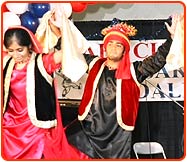As Baisakhi is one of the major festivals for Sikhs, people in Punjab wear bright new dress to mark the occasion. Kurta and lungi or pajama is a typical dress for men in Punjab while women go in for salwar-kamiz or lehanga-choli. Women further adorn themselves with heavy jewelry of various kinds. Here, we will discuss the traditional dress of bhangra and giddha to present to you the feel of the Baisakhi festival as celebrated in Punjab.
Dress for Bhangra is as colourful and vibrant as the Bhangra dance itself. Bhangra costumes effectively portrays the rich and vivid colors of rural Punjab and also the zest for life of Punjabi folk. Bhangra costume is simple and is normally worn by the men in rural Punjab, in lighter hues though ! Before we study how the Bhangra costume looks like let us see what exactly constitutes the traditional Bhangra dress for men !!
 One of the most striking features of bhangra dress or shall we say the pride of bhangra dress is the pag. The bhangra pug is different from normal Sikh pag. It resembles more with the turban tying style followed by jatts in rural Punjab. The pag is further adorned with fan shaped turla. Traditionally, turla is made from one end of the heavily starched pag. At times, performers prefer to attach a more fancy fan-like turla. Pag is further highlighted with the use of gota (broad golden lace). Many dancers also tie colourful chunni around their waist.
One of the most striking features of bhangra dress or shall we say the pride of bhangra dress is the pag. The bhangra pug is different from normal Sikh pag. It resembles more with the turban tying style followed by jatts in rural Punjab. The pag is further adorned with fan shaped turla. Traditionally, turla is made from one end of the heavily starched pag. At times, performers prefer to attach a more fancy fan-like turla. Pag is further highlighted with the use of gota (broad golden lace). Many dancers also tie colourful chunni around their waist.
Quite often the kurta of bhangra dancer is in white color but the use of other bright colours can also be normally observed in modern times. Lungi, vest and pag are of the same colour. Bright shades like yellow (to symbolize sarson, mustard), green (meaning prosperity), red (auspicious saffron) are mostly chosen for these. Lower part of a bhangra dress is a lungi. This is a rectangular piece of cloth tied around the waist. Men also wear juttis (Punjabi shoes), but dance barefoot.
Traditional dress for gidda is quite elegant. It adds charm to feminine grace and is comfortable enough to allow women to perform giddha dance with ease. Giddha dress is quite simple and one can find women in rural Punjab donning it everyday. The only difference is that costume for giddha makes use of brighter colors and is complemented with heavy jewellery.
Though salwar kammez is quite popular amongst women performing giddha dance but some also like to go in for lehanga (long flowing skirt) and choli (blouse). Sometimes women also wear sharraras (ghagara with split pants). In case of salwaar kameez, usually the kameez is of contrasting color from the dupatta and salwaar. In a gidda costume dupatta is not necessarily worn on the head.
Women performing giddha dance also adorn themselves with a lot of jewellery including bangles, tikka, jhumkas, necklace and nath (nose ring). Characteristic feature of gidda dress is a paranda - a tassle that is woven into the braid. Womenfolk love to go in for longer and fancier parandas.
Copyright © 2005- www.baisakhifestival.com. All Rights Reserved